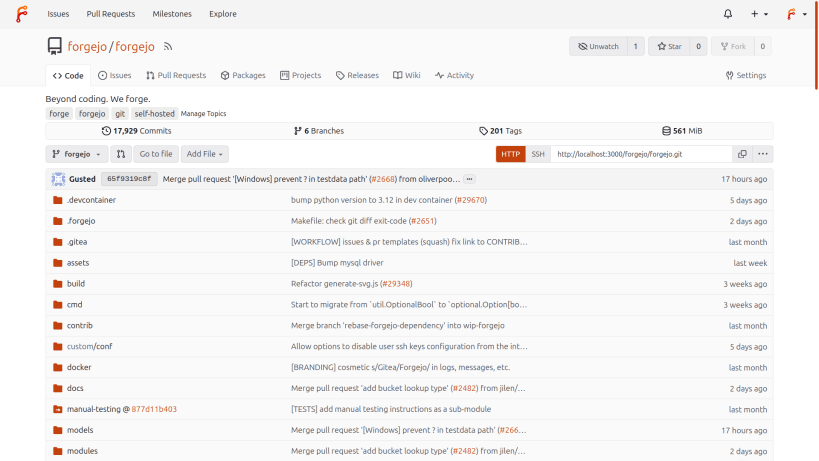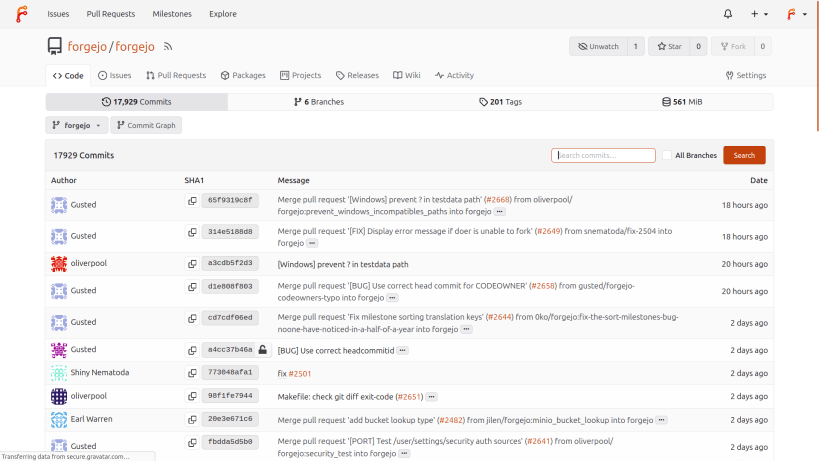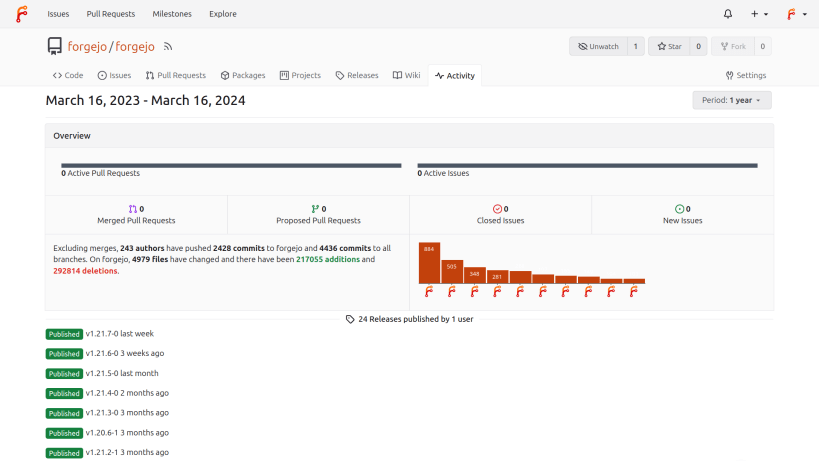




Welcome to Forgejo
Hi there! Tired of big platforms playing monopoly? Providing Git hosting for your project, friends, company or community? Forgejo (/for'd͡ʒe.jo/ inspired by forĝejo – the Esperanto word for forge) has you covered with its intuitive interface, light and easy hosting and a lot of builtin functionality.
Forgejo was created in 2022 because we think that the project should be owned by an independent community. If you second that, then Forgejo is for you! Our promise: Independent Free/Libre Software forever!
What does Forgejo offer?
If you like any of the following, Forgejo is literally meant for you:
Learn more
Dive into the documentation, subscribe to releases and blog post on our website, find us on the Fediverse or hop into our Matrix room if you have any questions or want to get involved.
Get involved
If you are interested in making Forgejo better, either by reporting a bug or by changing the governance, please take a look at the contribution guide.
Snap specific information
This snap is currently published as an evaluation. It is built by Alan Pope using configuration hosted at this repo: https://codeberg.org/forgejo-contrib/snap
See the following issue for more information: https://codeberg.org/forgejo/forgejo/issues/2542
Installation
The snap is published for 64-bit x86 and ARM architectures. It can be installed on a local workstation, server, or Raspberry Pi.
snap install forgejo
Setup
Visit http://localhost:3000 to start Forgeo configuration. Use a local SQLite database for the simplest configuration.
You are about to open
Do you wish to proceed?
Thank you for your report. Information you provided will help us investigate further.
There was an error while sending your report. Please try again later.
Snaps are applications packaged with all their dependencies to run on all popular Linux distributions from a single build. They update automatically and roll back gracefully.
Snaps are discoverable and installable from the Snap Store, an app store with an audience of millions.

Snap is available for Red Hat Enterprise Linux (RHEL) 8 and RHEL 7, from the 7.6 release onward.
The packages for RHEL 7, RHEL 8, and RHEL 9 are in each distribution’s respective Extra Packages for Enterprise Linux (EPEL) repository. The instructions for adding this repository diverge slightly between RHEL 7, RHEL 8 and RHEL 9, which is why they’re listed separately below.
The EPEL repository can be added to RHEL 9 with the following command:
sudo dnf install https://dl.fedoraproject.org/pub/epel/epel-release-latest-9.noarch.rpm
sudo dnf upgrade
The EPEL repository can be added to RHEL 8 with the following command:
sudo dnf install https://dl.fedoraproject.org/pub/epel/epel-release-latest-8.noarch.rpm
sudo dnf upgrade
The EPEL repository can be added to RHEL 7 with the following command:
sudo rpm -ivh https://dl.fedoraproject.org/pub/epel/epel-release-latest-7.noarch.rpm
Adding the optional and extras repositories is also recommended:
sudo subscription-manager repos --enable "rhel-*-optional-rpms" --enable "rhel-*-extras-rpms"
sudo yum update
Snap can now be installed as follows:
sudo yum install snapd
Once installed, the systemd unit that manages the main snap communication socket needs to be enabled:
sudo systemctl enable --now snapd.socket
To enable classic snap support, enter the following to create a symbolic link between /var/lib/snapd/snap and /snap:
sudo ln -s /var/lib/snapd/snap /snap
Either log out and back in again or restart your system to ensure snap’s paths are updated correctly.
To install Forgejo, simply use the following command:
sudo snap install forgejo
Browse and find snaps from the convenience of your desktop using the snap store snap.

Interested to find out more about snaps? Want to publish your own application? Visit snapcraft.io now.